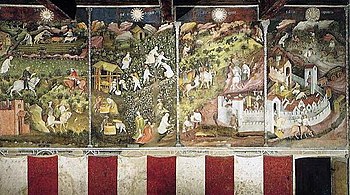Cycle of months
The cycle of the months (Italian: Ciclo dei Mesi or I dodici mesi ) is a group of fresco paintings in the eagle tower of the Castello del Buonconsiglio in Trento .
history
Georg von Liechtenstein, who ruled here as prince-bishop from 1390 to 1407 , set up his private rooms in the eagle tower of the Trento castle complex and had them decorated with paintings, of which only the monthly pictures in the central area of the tower have been preserved. An artist name cannot be safely associated with the frescoes. Whether Wenceslaus, who is named as the bishop's court painter in 1497, was involved here, and whether he was Bohemian, can only be guessed. Today we all agree that the artist of the monthly pictures came from the north. This is supported by peculiar motifs (selection of typical plants and draft animals, "Gothic" architecture) and stylistic indications (vertically adding instead of perspective-depth spatial composition). The dating of the paintings cannot be narrowed down more precisely than with the reign of the bishop (1390–1407).
Representations
The rectangular hall is surrounded by 12 picture fields (of which only March was lost due to fire), which are separated by painted columns and each offer a "view" of the topographically continuous, but seasonally changing mountain landscape. The eleven illustrations show, mostly in the background, the various farming activities in the respective month (agriculture, pasture and viticulture), but above all the amusements of noble society corresponding to the respective season (falcon hunt and training of birds, tournaments, snowball fights, etc.) . The changes in the landscape over the course of the year are also closely observed in the depictions of nature: The winter landscape is bare and is brightened up by the snow. Lush vegetation shows up in spring, in summer the harvest is depicted as the main task of agriculture, and autumn (November) shows the dry leaves on the ground. The attention to detail can be seen in the different depiction of clothing in the respective time as well as the colorful robes of the nobles in contrast to the simpler, practical clothing of the working population. A wide variety of architectures complete the picture of a mountainous, but consistently culturally shaped landscape.
meaning
The representations are among the most important and inventive European examples of the international Gothic , which around 1400 had established a network of artistic relationships between the European courts. The Trento monthly pictures demonstrate the role of the Alpine region as a cultural interface between the north (France, Germany, Bohemia ) and the south (Italy).
photos
bibliography
- M. Welber: Affreschi dei mesi di torre d'Aquila Castello Buonconsiglio (sec. XV) . 1995, ISBN 8886246390 .
- Pierluigi De Vecchi, Elda Cerchiari: I tempi dell'arte . volume 2, Bompiani, Milano 1999.
- Alfred Stange: German painting of the Gothic, Volume 10 , Verlag Kraus Reprint, 1969, pages 139ff
- M. Rasmo: The frescoes in the eagle tower in Trento , Rovereto 1962
- Manfred Wundram, in: The Parler and the beautiful style 1350–1400. , Vol. 1, Cologne (Schnütgen-Museum) 1978, pp. 38-39.
See also
Individual evidence
- ↑ Sabine Lorenz-Schmidt: On the value and change of female work: Gender-specific division of labor in agriculture in images of the late Middle Ages and early modern times . Steiner, Stuttgart 1998, ISBN 3-515-06988-7 , pp. 65–66 ( preview in Google Book Search).











